Are you looking for a stunning tattoo that has deep cultural significance? Look no further than Japanese flower tattoos. These tattoos are beautiful, intricate, and meaningful all at once. In this article with Impeccable Nest, we will explore the different Japanese flower tattoo meanings and designs to help you make an informed decision on your next tattoo.
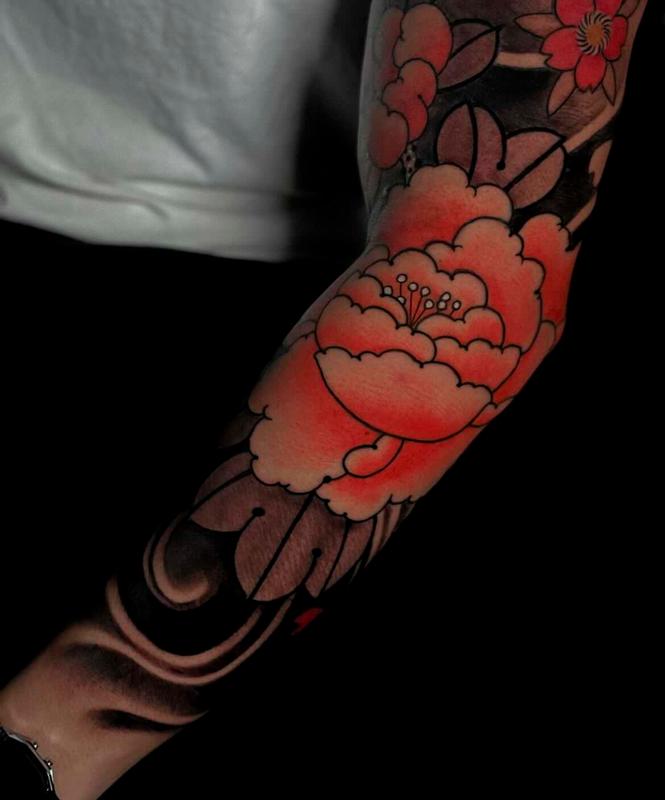
Japanese Flower Tattoo Meanings: Unlocking the Symbolism Behind
Flowers have always played an important role in Japanese culture, from tea ceremonies to art. Each flower is said to hold its own unique meaning, making them perfect for tattoos. Let’s delve into some of the most popular Japanese flowers and their meanings.
Cherry Blossom Tattoo Meaning
Tattoos have become a popular form of self-expression and appreciation for art in recent years. Japanese tattoos, in particular, have attracted a great deal of attention due to their intricate designs and rich cultural significance. One of the most prominent motifs in Japanese tattooing is the cherry blossom or sakura.
Cherry blossoms are a symbol of spring and renewal in Japan. The delicate pink flowers bloom for a short period every year, typically from late March to early May, before falling from the tree and scattering on the ground like snowflakes. This fleeting beauty is often used as a metaphor for the transience of life, reminding people to cherish each moment and appreciate the beauty in impermanence.
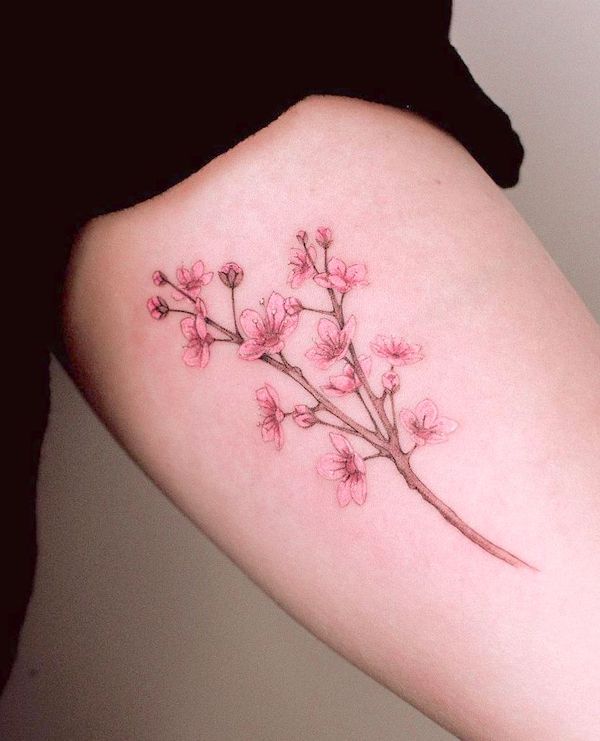
In Japanese culture, cherry blossoms have been celebrated for centuries. They are featured prominently in traditional art, literature, and music, as well as in modern pop culture. The annual Sakura Festival, held throughout Japan and other parts of the world, is a time for people to gather under the blooming trees and celebrate the arrival of spring.
When it comes to tattoos, cherry blossoms are a popular choice for both men and women. They are often depicted as a single flower or in clusters, with or without other elements such as branches, birds, or symbols. The placement of the tattoo can also vary, with common spots including the back, shoulder, arm, and ankle.
The meaning behind a cherry blossom tattoo can vary depending on the individual’s personal interpretation and the context in which the tattoo is placed. In general, however, the tattoo may symbolize new beginnings, growth, and the beauty of life’s fleeting moments. It may also represent the idea of living in the present and finding joy in the small things in life.
Overall, cherry blossom tattoos are a timeless and beautiful way to pay homage to Japanese culture while also expressing one’s own identity and values. Whether you choose to get a cherry blossom tattoo for its symbolic meaning or simply for its aesthetic appeal, it is sure to be a stunning addition to your body art collection.
Lotus Flower Tattoo Meaning
Japanese flower tattoos are a popular form of body art that carries significant cultural symbolism and meaning. Among these, the lotus flower, or renge, holds a special place in Japanese culture due to its association with spiritual enlightenment and rebirth.
In Japanese culture, the lotus flower is regarded as a symbol of purity and perfection. It is believed that the lotus flower represents the journey towards spiritual awakening and enlightenment, which is seen as the ultimate goal of human existence. The lotus is often depicted alongside Buddhist deities, such as Buddha or Kannon, to signify their divine nature and spiritual power.
One of the most striking characteristics of the lotus flower is its ability to emerge from murky waters, clean and bright. This process is seen as a symbol of rebirth, renewal, and transformation. The lotus flower is often used to represent the idea that even in the midst of adversity, it is possible to rise above and bloom into one’s full potential.
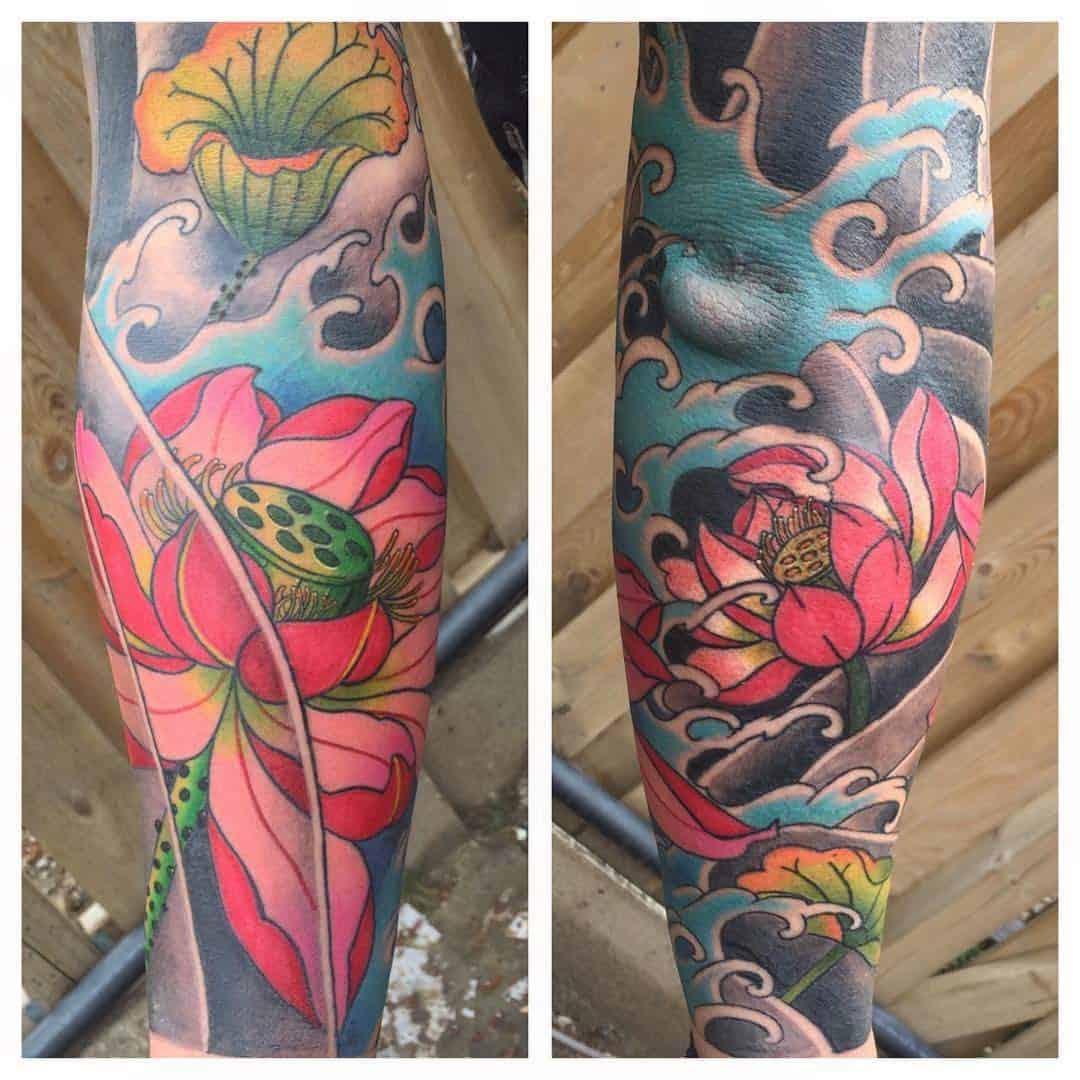
Moreover, the color of the lotus flower also carries important symbolic meaning in Japanese culture. White lotus flowers represent purity and innocence, while red lotus flowers signify love, passion, and compassion. Pink lotuses are associated with the divine feminine, and yellow lotuses symbolize spiritual ascension and enlightenment.
In Japanese flower tattoo designs, the lotus is often depicted in various stages of growth, with each stage representing different aspects of the spiritual journey. Some designs may feature the lotus bud, which symbolizes the potential for growth and transformation. Others may show the lotus in full bloom, signifying the attainment of spiritual enlightenment and purity.
Overall, the lotus flower is a powerful and meaningful image in Japanese culture and Japanese flower tattoos. Its symbolism reflects the human desire for spiritual growth, renewal, and transformation, making it a popular choice among those seeking to express their own spiritual journey through body art.
Chrysanthemum Tattoo Meaning
The art of tattooing has been practiced in Japan for centuries, with some of the earliest records of tattoos dating back to the 5th century. Over time, tattoo designs have evolved and become increasingly complex, with many incorporating symbolic elements that reflect key themes and values within Japanese culture.
One of the most popular floral motifs used in Japanese tattoo designs is the chrysanthemum, or kiku. This flower has a long and storied history in Japan, and it is often associated with the imperial family. In fact, the chrysanthemum appears on the Japanese passport, serving as a symbol of national pride and identity.
When used in tattoos, the chrysanthemum can carry a variety of meanings, depending on the specific design and context. However, one of the most common interpretations is that the flower represents longevity and rejuvenation. This is due in part to the fact that the chrysanthemum blooms in the autumn, a season often associated with maturity and the passage of time.
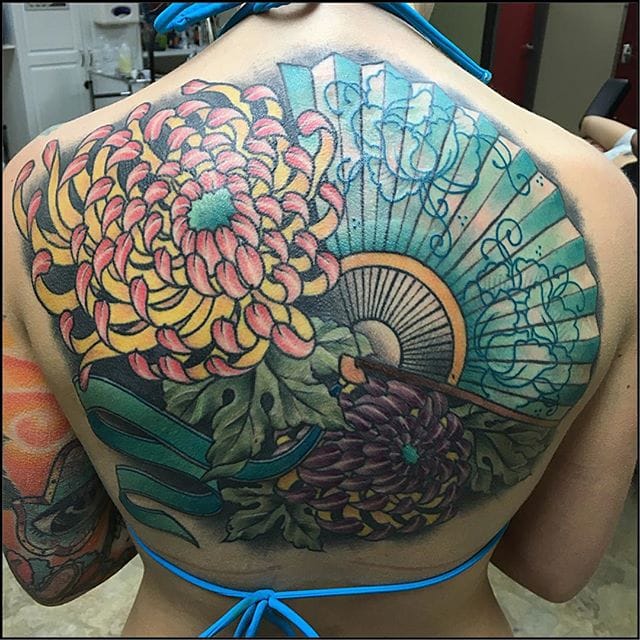
By choosing to incorporate a chrysanthemum tattoo into their body art, individuals may be expressing a desire for long life and vitality. They may also be drawing inspiration from the resilience and beauty of this hardy flower, which has long been admired by artists and poets alike.
In addition to its symbolic significance, the chrysanthemum is also valued for its aesthetic qualities. With its intricate petals and delicate coloration, this flower can make for a stunning and highly detailed tattoo design. Many artists use the chrysanthemum as a focal point for larger, more elaborate tattoos that incorporate other elements of Japanese art and culture.
Whether viewed as a symbol of national pride, a representation of personal values, or simply a beautiful and meaningful design choice, the chrysanthemum remains an enduring presence in the world of Japanese tattoo art. For those looking to explore this rich tradition and express themselves through body art, a chrysanthemum tattoo may be the perfect choice.
Peony Tattoo Meaning
Tattoos have been a part of human culture for centuries, and the art of tattooing has evolved greatly over time. In Japan, tattoos are deeply rooted in tradition and have held significant cultural, religious, and social significance throughout history. Japanese tattoo designs often feature iconic imagery such as dragons, koi fish, and cherry blossoms, but perhaps one of the most beloved and meaningful floral motifs is the peony.
The peony, known as botan in Japanese, is a beautiful flowering plant that is native to Asia and Europe. It blooms in a wide range of colors, including pink, red, white, and yellow, and is prized for its lush, rounded petals and sweet fragrance. In traditional Japanese art, the peony is a popular subject matter due to its beauty and rich symbolism.
The peony holds special meaning in Japanese culture, representing wealth, prosperity, and good fortune. It is thought to bring happiness and success in all areas of life, from love and relationships to business and finance. As such, the peony is a popular design choice for those seeking to attract positive energy and good luck into their lives.
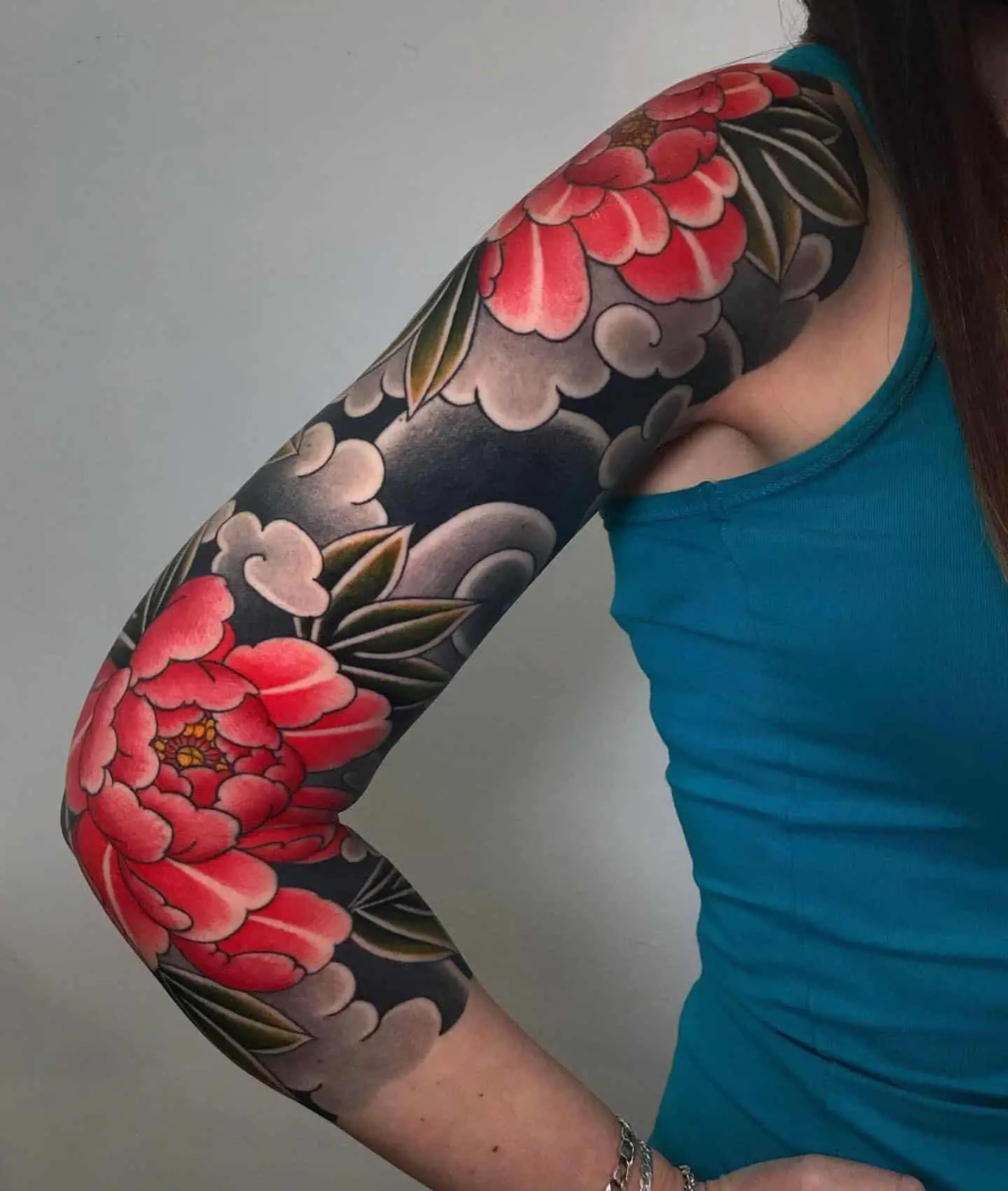
In addition to its auspicious symbolism, the peony is also associated with romance and femininity. It is often depicted alongside other flowers, such as cherry blossoms or chrysanthemums, in paintings and textiles. In Japanese mythology, the peony is said to be the favorite flower of the goddess Kannon, who is associated with compassion and mercy.
While the peony has a rich history and symbolic meaning in Japanese culture, it is important to approach the design of a Japanese flower tattoo with respect and consideration. Many traditional Japanese tattoo artists view their craft as a spiritual practice and adhere to strict rules and guidelines regarding the placement, size, and style of the tattoo. It is important to research and choose a reputable artist who understands the cultural significance of the peony and can create a design that honors its history and meaning.
In conclusion, the peony is a classic and beloved Japanese flower that holds deep symbolic meaning. As a tattoo design, it represents wealth, prosperity, and good fortune, as well as romance and femininity. When choosing a Japanese flower tattoo featuring the peony, it is important to approach the design with respect and consideration for its cultural significance.
Wisteria Tattoo Meaning
Japanese tattoos have been an integral part of the culture for centuries. They are not just a form of body art but also serve as symbols of cultural heritage, personal beliefs, and aspirations. Japanese flower tattoos are particularly popular among tattoo enthusiasts due to their intricate designs and deep meanings. One of the most sought-after flower tattoos in Japan is the Wisteria or “fuji” in Japanese.
The Wisteria is an alluring purple flower that blooms during late spring and early summer. It is highly valued in Japanese culture for its beauty and fragrant aroma. In Japanese folklore, it is believed that wisteria flowers have magical powers that can make wishes come true if hung outside someone’s home. The flower is also associated with love, longevity, and perseverance, making it a popular choice for tattoo designs.
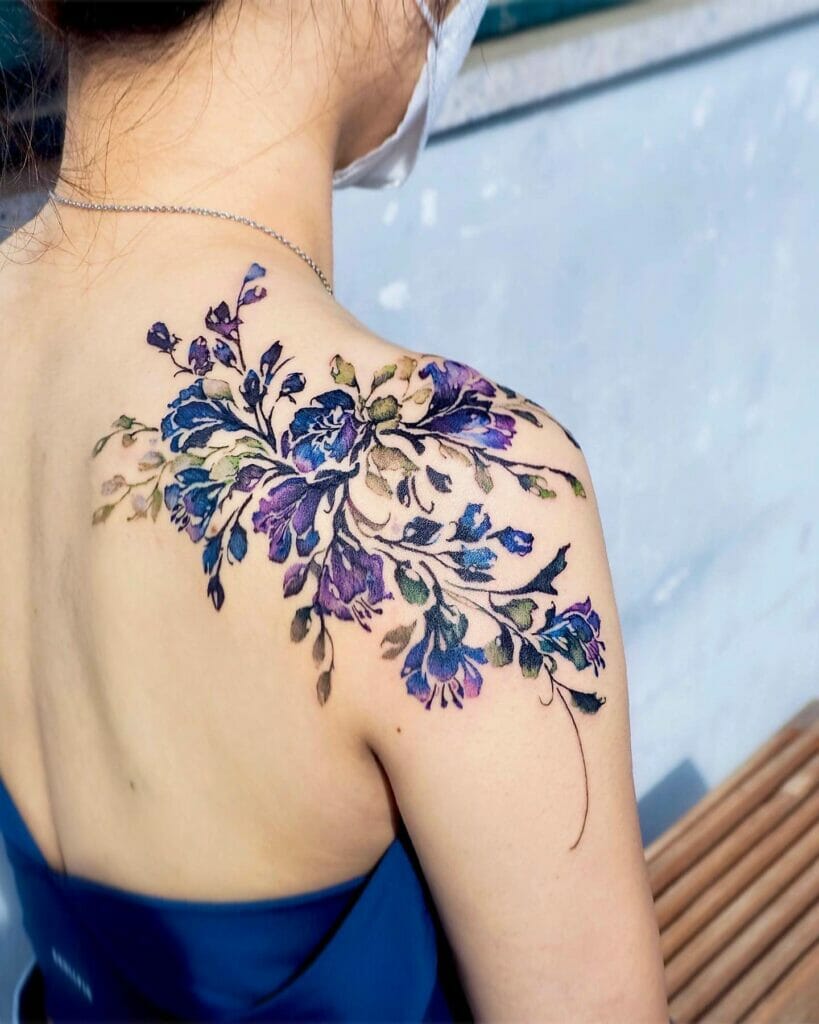
Wisteria tattoo designs often feature the flowers in full bloom, with their cascading petals and vibrant colors. The tattoo may also include other elements such as leaves, vines, and butterflies to enhance its meaning and beauty. In Japanese tattoo art, the placement of the tattoo is crucial as it can affect the meaning of the design. For instance, a wisteria tattoo on the back symbolizes perseverance and resilience while a tattoo on the arm represents strength and courage.
Apart from its aesthetic appeal, the Wisteria tattoo holds deep symbolic significance. The flower represents long life, as it can survive for over 100 years if cared for properly. This quality makes it an excellent choice for people who want to express their desire for longevity and vitality. The flower is also associated with beauty, grace, and elegance, making it a popular motif for women who want to highlight their femininity.
Perseverance is another key meaning associated with the Wisteria tattoo. The plant can grow and flourish in harsh conditions, such as drought, heat, and poor soil quality. Its ability to thrive despite adversity is a symbol of resilience and determination. A wisteria tattoo can serve as a reminder to keep pushing forward, even when faced with challenges.
In conclusion, the Wisteria or “fuji” is a highly valued flower in Japanese culture, symbolizing love, beauty, longevity, and perseverance. Its popularity as a tattoo design is due to its aesthetic appeal, deep meanings, and versatile placement options. If you are planning to get a Wisteria tattoo, it is essential to understand its significance and choose a design that resonates with your personality and aspirations.
Japanese Flower Tattoo Designs
Now that we have explored the meanings behind some popular Japanese flowers let’s take a look at some beautiful Japanese flower tattoo designs.
Colorful Cherry Blossom Tattoo
A colorful cherry blossom tattoo captures the essence of Springtime in Japan. The delicate pink petals are often paired with light blue or green leaves to create a stunning contrast. This tattoo is perfect for those who want to celebrate new beginnings and the fleeting beauty of life.
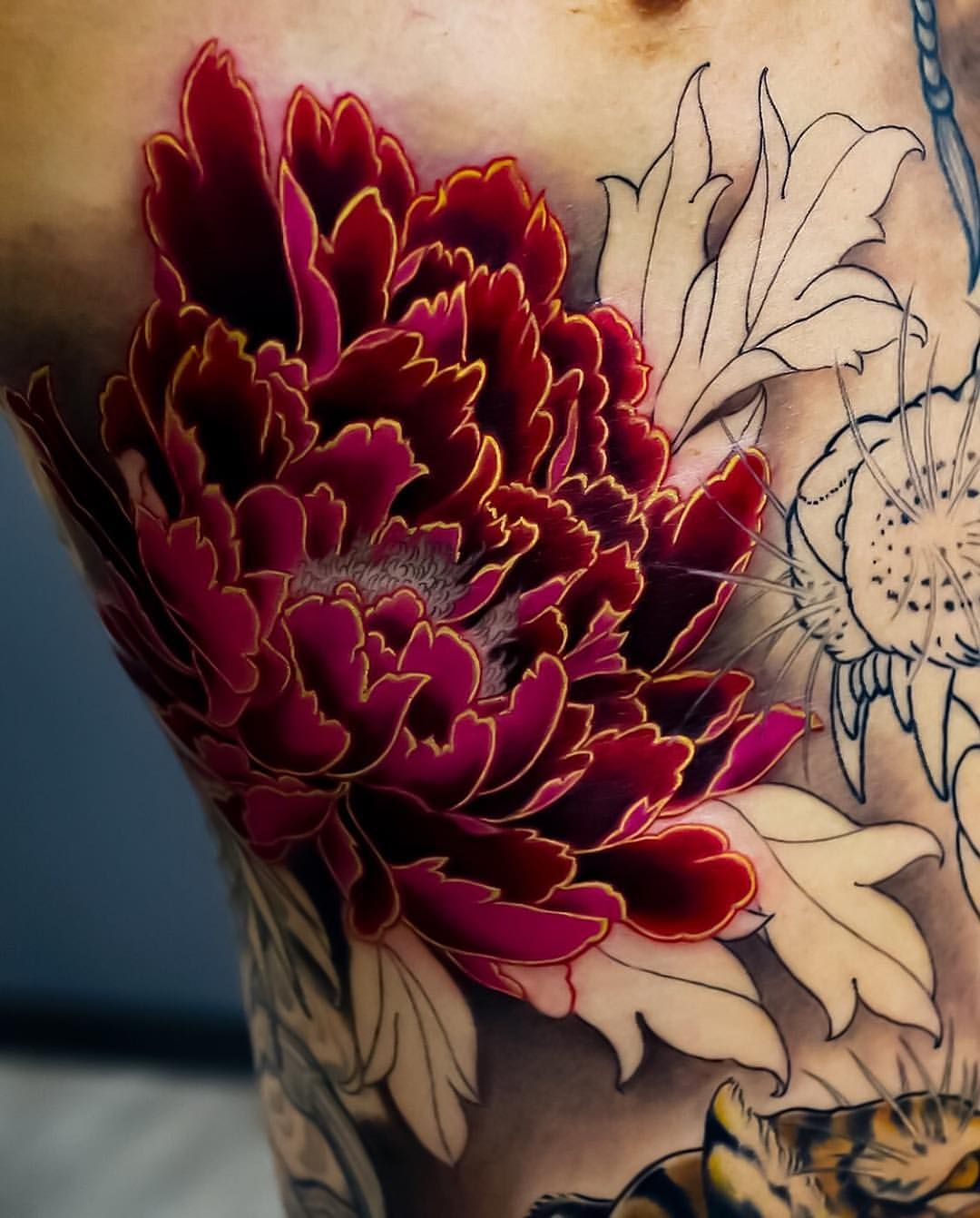
Black and White Lotus Flower Tattoo
A black and white lotus flower tattoo is a classic choice for anyone seeking enlightenment. The simple design allows the intricate details of the flower to shine through. The shading in this tattoo creates depth and a sense of mystery, making it perfect for those seeking a more subtle tattoo.

Chrysanthemum Sleeve Tattoo
A chrysanthemum sleeve tattoo is a statement piece that represents longevity. These flowers are often depicted in different colors and sizes to create a dynamic composition. A skilled tattoo artist can create a stunning 3D effect, giving the impression that the flowers are blooming right off of your skin.
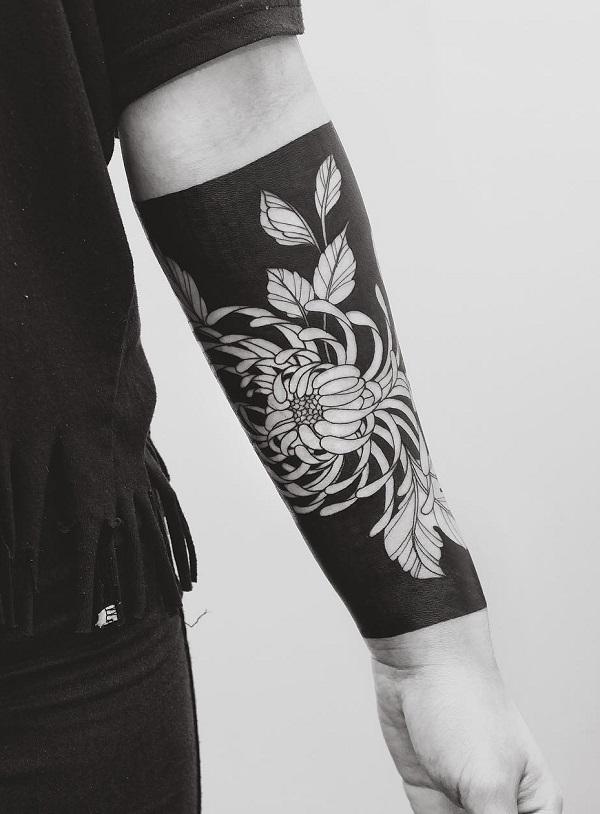
Peony Back Tattoo
A peony back tattoo is a bold choice that represents wealth and prosperity. The large size of this tattoo makes it perfect for the back. A talented tattoo artist can use shading and color to create a stunning depth to the design.

Wisteria Arm Tattoo
A wisteria arm tattoo is a unique way to represent love and beauty. This tattoo looks stunning on the upper arm, where the elongated shape of the wisteria flowers can be accentuated. A watercolor effect can be added to make this tattoo even more striking.
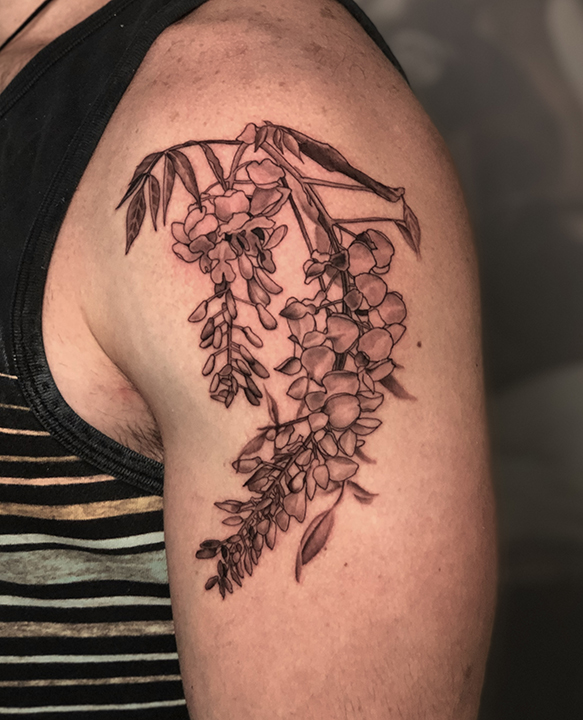
How to Use Japanese Flower Tattoo Meanings
Japanese flower tattoo meanings can be used in many ways. They can be the focal point of your tattoo or used to complement other elements. For example, a cherry blossom branch could be added to a traditional Japanese sleeve tattoo to represent new beginnings.
Examples of Japanese Flower Tattoo Meanings
There are endless possibilities when it comes to Japanese flower tattoos. An example could be a black and white lotus flower tattoo on the wrist, representing the journey towards enlightenment. Another example could be a colorful chrysanthemum sternum tattoo, symbolizing rejuvenation and longevity.
Comparisons for Japanese Flower Tattoo Meanings
When comparing different Japanese flower tattoo meanings, it is important to consider what resonates with you personally. Cherry blossoms may represent new beginnings, but peonies may hold more significance for someone seeking prosperity and good fortune. Ultimately, the decision comes down to personal preference and what emotions you want your tattoo to evoke.
Conclusion
Japanese flower tattoo designs make deeply meaningful choices thanks to the wealth of symbolism in Japanese culture. Timeless blooms like the chrysanthemum, sakura, peony, and lotus carry messages of love, honor, wisdom, and the passage of time. By selecting flowers with personal significance, you can create a beautiful and personal floral tattoo. With striking colors and graceful beauty, Japanese flowers represent cultural legacy and important life lessons in tattoo art.

I am Harvey Berry, a tattoo enthusiast who has immersed himself in the diverse world of ink, passionately exploring the beauty and artistry within each tattoo. My mission extends beyond uncovering the aesthetics of tattooing; it involves sharing in-depth knowledge across all aspects of this art form.
Fueled by genuine curiosity and love for every facet of tattooing, I have diligently crafted well-researched articles, with a special focus on the Tattoo Meaning of Impeccable Nest section. Here, my aim is to help the tattoo community gain a deeper understanding of the meanings and values embedded in each tattoo.
One of my primary goals is to encourage responsible decision-making when it comes to getting inked. I recognize that choosing to get a tattoo is a significant personal decision that requires careful consideration. Hence, I provide diverse resources covering the meaning of tattoos, the tattooing process, aftercare tips, and other valuable information.
Whether you are a seasoned tattoo enthusiast or embarking on your first exploration of the world of body art, I aspire to be a reliable resource for you at every step of your journey. I hope that my extensive knowledge of tattoos, especially in the Tattoo Meaning section, will assist you in finding inspiration to express yourself through the art of tattoos.
